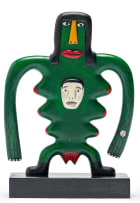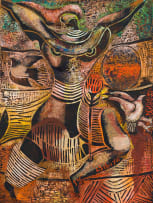Icons, a pair
Cecil Skotnes
Incl. Buyer's Premium & VAT
About this Item
each signed
Notes
Born to missionary parents, Cecil Skotnes featured religious, ancestral and spiritual iconography in his work throughout his life. From the 1960s, he made large scale murals and panels for various Roman Catholic churches across the country and in 1971 he exhibited a body of work in an exhibition titled Icons at the Totem Meneghelli Gallery in downtown Johannesburg. In the 1970s Skotnes made the Epic of Gilgamesh for KWV and produced several Madonna images based on Michelangelo's 1549 drawing Annunciation to the Virgin. In the latter part of his life, he presented his version of The Last Supper, a large triptych completed in 1995, to the Santa Sophia Institute for Catholic Education in Waterkloof, Pretoria. From the early 1980s, Skotnes made small wooden panels embellished with geometrically scored brass surrounding the artwork. In the present lot, a pair of small-scale works, he casts two women as icons in shades of ochre, red and white. Alluding to the spiritual world beyond, he crowns the heads of the naked figures with lines of tracery suggesting veils, mantillas or even, paradoxically, the wimples typically worn by Roman Catholic nuns, who devote their lives to God and take a vow of chastity. Linear incisions in the wood link these traceries to the abstracted forms to the right in each work. These figures are more schematic, stylised, simplified and less structured than many of Skotnes's large-scale, more complex, incised panels. These icons appear to hark back to the woodblocks made for the artist's portfolios, such as the Assassination of Shaka in 1973 and White Monday Disaster in 1974.






